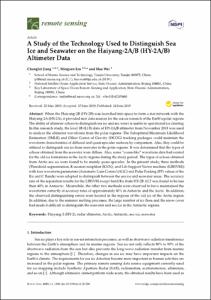| dc.contributor.author | Jiang, Chengfei | |
| dc.contributor.author | Mingsen, Lin | |
| dc.contributor.author | Hao Wei | |
| dc.coverage.spatial | Arctic Region | en_US |
| dc.date.accessioned | 2023-05-10T00:38:01Z | |
| dc.date.available | 2023-05-10T00:38:01Z | |
| dc.date.issued | 2019 | |
| dc.identifier.citation | Jiang, C., Lin, M. and Wei, H. (2019) A Study of the Technology Used to Distinguish Sea Ice and Seawater on the Haiyang-2A/B (HY-2A/B) Altimeter Data. Remote Sensing, 11:1490, 22pp. DOI: https://doi.org/10.3390/rs11121490 | en_US |
| dc.identifier.uri | https://repository.oceanbestpractices.org/handle/11329/2204 | |
| dc.description.abstract | When the Haiyang-2B (HY-2B) was launched into space to form a star network with the Haiyang-2A (HY-2A), it provided new data sources for the sea ice research of the Earth's polar regions. The ability of altimeter echoes to distinguish sea ice and sea water is usable in operational ice charting. In this research study, the level 1B (L1B) data of HY-2A/B altimeter from November 2018 was used to analyze the altimeter waveforms from the polar regions. The Suboptimal Maximum Likelihood Estimation (SMLE) and Offset Center of Gravity (OCOG) tracking packages could maintain the waveform characteristics of diffused and quasi-specular surfaces by comparison. Also, they could be utilized to distinguish sea ice from seawater in the polar regions. It was determined that the types of echoes obtained from the seawater were diffuse. Also, some ocean-like waveform data had existed for the old ice formations in the Arctic regions during the study period. The types of echoes obtained from Arctic sea ice were found to be mainly quasi-specular. In the present study, three methods (Threshold segmentation, K-nearest-neighbor (KNN), and Lib-Support Vector machine (LIBSVM)) with four waveform parameters (Automatic Gain Control (AGC) and Pulse Peaking (PP) values of the Ku and C Bands) were adopted to distinguish between the sea ice and seawater areas. The accuracy rate of the separation results for the LIBSVM except band Ku from HY-2B ALT was found to be less than 40% in Antarctic. Meanwhile, the other two methods were observed to have maintained the waveforms correctly at accuracy rates of approximately 80% in Antarctic and the Arctic. In addition, the observed distinguishing errors were located in the regions of the old ice of the Arctic region. In addition, due to the summer melting processes, the large number of ice floes and the snow cover had made it difficult to distinguish the seawater and sea ice in the Antarctic regions. | en_US |
| dc.language.iso | en | en_US |
| dc.rights | Attribution 4.0 International | * |
| dc.rights.uri | http://creativecommons.org/licenses/by/4.0/ | * |
| dc.subject.other | Haiyang-2 | en_US |
| dc.subject.other | Sea Ice | en_US |
| dc.subject.other | Seawater | en_US |
| dc.title | A Study of the Technology Used to Distinguish Sea Ice and Seawater on the Haiyang-2A/B (HY-2A/B) Altimeter Data. | en_US |
| dc.type | Journal Contribution | en_US |
| dc.description.refereed | Refereed | en_US |
| dc.format.pagerange | 22pp. | en_US |
| dc.identifier.doi | http://dx.doi.org/10.3390/rs11121490 | |
| dc.subject.parameterDiscipline | Cryosphere | en_US |
| dc.subject.instrumentType | radar altimeters | en_US |
| dc.subject.dmProcesses | Data processing | en_US |
| dc.bibliographicCitation.title | Remote Sensing | en_US |
| dc.bibliographicCitation.volume | 11 | en_US |
| dc.bibliographicCitation.issue | 1490 | en_US |
| dc.description.sdg | 14.a | en_US |
| obps.contact.contactname | Chengfei Jiang | |
| obps.contact.contactemail | jcf@mail.nsoas.org.cn | |
| obps.resourceurl.publisher | https://www.mdpi.com/2072-4292/11/12/1490 | |
 Repository of community practices in Ocean Research, Applications and Data/Information Management
Repository of community practices in Ocean Research, Applications and Data/Information Management

